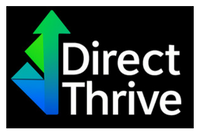Crafting a Standout CV: Tips to Capture Attention and Land Interviews
- Aaron Johnson

- Aug 13
- 3 min read

In today’s competitive job market, your CV isn’t just a document—it’s your personal marketing tool. It’s the first impression an employer has of you, and in many cases, it determines whether you get invited for an interview or not. A powerful CV does more than list your work history—it tells your professional story, highlights your value, and positions you as the solution to an employer’s needs.
At DirectThrive, we help professionals craft CVs that don’t just get read—they get remembered. Here’s how you can do the same.
1. Start With a Strong Personal Profile
Your personal profile (or professional summary) should be a concise 3–4 sentence introduction that sells you in seconds. Think of it as your career “elevator pitch.”
Highlight your key skills and achievements that align with the role you’re targeting.
Use confident, action-focused language that communicates impact.
Avoid clichés like “hardworking” and “team player” unless backed up by proof.
Example:“Results-driven Marketing Specialist with 6+ years’ experience delivering multi-channel campaigns that increase engagement and sales. Skilled in data-driven strategy, brand positioning, and digital content creation, with a proven track record of achieving 25% year-on-year growth.”
2. Focus on Achievements, Not Just Duties
Employers want to know what you accomplished, not just what you did. Instead of simply listing responsibilities, quantify your successes:
Use numbers, percentages, and tangible results where possible.
Start bullet points with strong action verbs like “led,” “increased,” “developed,” or “implemented.”
Instead of:“Responsible for managing social media accounts.”
Write:“Developed and executed a social media strategy that increased follower engagement by 45% in 6 months.”
3. Tailor Your CV for Every Role
A generic CV can blend into the pile. To stand out:
Analyse the job description and incorporate keywords.
Highlight experience and skills that directly match the role.
Remove irrelevant details that could distract from your value.
Remember, tailoring your CV shows an employer you’re serious about the position and understand their needs.
4. Use a Clear, Professional Layout
First impressions matter—and a cluttered CV can hurt you before your words are even read.
Keep it two pages maximum (one page for early-career professionals).
Use consistent formatting, with clear headings and bullet points.
Avoid overusing colours or graphics—save the creativity for your portfolio if applicable.
5. Include Relevant Skills and Training
A “Skills” section is a quick way for employers to see your strengths at a glance.
Include both hard skills (e.g., data analysis, project management) and soft skills (e.g., leadership, communication).
Add any certifications, training, or professional memberships that are relevant to your industry.
6. Don’t Forget the ATS (Applicant Tracking System)
Many companies use ATS software to filter CVs before a human ever sees them.
Use keywords from the job ad naturally throughout your CV.
Avoid images, tables, and unusual fonts that may confuse the software.
7. Proofread—Then Proofread Again
Spelling and grammar mistakes can instantly damage your credibility.
Use a spell-check tool, but also read your CV aloud to catch awkward phrasing.
Consider asking a friend or a professional CV consultant to review it.
Final Thought
A powerful CV is more than a history of your career—it’s a strategic, well-crafted document that positions you as the best candidate for the job. At DirectThrive, we specialise in helping clients not only stand out on paper but also feel confident walking into interviews.
If you’re ready to transform your CV into a tool that opens doors, get in touch with us today and take the first step toward your next career opportunity.


Comments